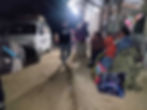Earlier this month, a rabbinical delegation headed to Mizoram in northeast India to conduct screening interviews for the Bnei Menashe community eagerly awaiting aliyah (Jewish migration to Israel). During their short stay in the state capital Aizawl from the first of December to the tenth of the month, the delegation paid a visit on Shabbat eve (Friday morning), December 5, 2025, to the Main Synagogue located in the Dawrpui West neighbourhood of central Aizawl.

The Shlomtzion synagogue, which currently serves as the spiritual home for a little over fifty members has been under community management since the 1990s when the property deed was acquired through the combined and tireless efforts of the Rabbi Eliyahu Avichail led Amishav organistaion, community elders and notable Christian well-wishers.
The synagogue hall was temporarily housed in a structure made of semi-durable materials: gypsum board walling on a wooden frame with corrugated metal sheet roofing. Over time, the congregation constructed a more durable brick and mortar synagogue hall and even built a rudimentary mikveh (ritual immersion pool).
By virtue of its prime location in central Aizawl, the visiting rabbinical delegation was mesmerized by the commanding city view as they stood at the synagogue balcony. They even inspected the three sifrei Torah (Torah scrolls) housed in the synagogue premises, one of which has the distinction of being donated by Rav Avichail. Before taking their leave, the delegation sat down to a modest morning meal at the synagogue dining hall. Gamliel Thomte, chairman of the Shlomtzion synagogue, noted, “In all my years I never could have imagined that such an august rabbinical delegation would not only visit and have a look at our synagogue, but that they would also sit down to a meal at our humble synagogue. I give thanks to Hashem who has graced us with the privilege of such esteemed guests”.

While the delegation carefully surveyed the synagogue, what caught their attention was the mikveh in the premises which was in sore need of repair but which had been put off due to the paucity of congregation funds. Rav Uriel Shlomi, spiritual overseer of the Bnei Menashe in Nof haGalil, northern Israel, immediately stepped in and handed over a handsome sum to the synagogue chairman, Gamliel Thomte. He discussed the manner in which the necessary repairs were to be conducted in line with halacha (Jewish law) and encouraged the congregation to keep the commandment of the mikveh close to their hearts.

The congregation fulfilled the charge by the rabbi with due alacrity and once the current round of aliyah interviews were completed, a communal work programme was announced by the synagogue elders and duly completed in time for Chanukah (Feast of Dedication), on Chanukah eve, December 14. A celebratory feast was organised on the eve of Zot Chanukah (the last night of Chanukah), December 21, to mark the joyous occasion of completing the mikveh repairs alongside a naming ceremony for the erstwhile unnamed mikveh.
With regard to the naming of the mikveh, the synagogue leadership put their heads together and after careful consideration agreed upon the name “Ohr Shalom” (Light of Peace). Three distinct ideas formed the basis for this name: firstly, the name of the donor, Rav Uriel (Light of Hashem); secondly, the contemporaneous festival of Chanukah, also known as Chag Urim (Festival of Lights); and thirdly, the name of the synagogue, Shlomtzion (Peace of Zion).
Congregants were spiritually uplifted by the attention and concern exhibited by the rabbi and expressed their deep gratitude. Leah Renthlei, a long-time member of the synagogue observed, “Observing niddah (ritual law regarding menstruation) followed by a purifying immersion in the mikveh is one of the key commandments charged to Jewish women. May Hashem richly bless this donation by Rav Shlomi and may it uplift all who immerse in the purifying waters of this mikveh in the years to come”.
Safira Pachuau, another congregant, reflected, “Although I am personally no longer bound by niddah, I am moved by how reverently Rav Shlomi holds the commandment of mikveh. I have used this incident as a vital learning opportunity to impress upon my young daughter the centrality of a mikveh in the life of a married Jewish woman”.
Nadav Hauhnar, treasurer of the Shlomtzion synagogue, shared effusively, “As a congregation we have deliberated on the pending repairs to the mikveh on several occasions, but have been held back on each instance by our meagre coffers. The visit by the rabbinical delegation and the open-hearted donation by Rav Shlomi are an answer from heaven to our financial difficulties. We express our immense gratitude to Rav Shlomi and especially to Hashem who has used the rabbi as an instrument of blessing for our congregation.”
With the completion of the necessary repairs as per the instructions of the rabbi, the Ohr Shalom mikveh at the Shlomtzion synagogue in Aizawl now stands ready to be used by all those who stand in need of its purifying waters. May the observation of the commandment regarding the mikveh be to the merit of all who immerse in it, and may it be to the merit of the Bnei Menashe waiting eagerly their aliyah to the holy land.













